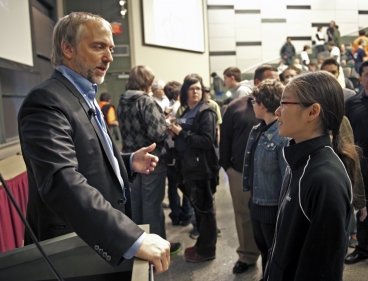For the past four months, high school students have been working in teams to program tiny robots to fly on board the International Space Station, as part of the Michigan Institute of Technology’s (MIT) competition, Zero Robotics Challenge. The robots called SPHERES were designed by students in the Space Systems Laboratory of MIT.
 "Richard Garriott speaks with a student at the 2011 Zero Robotics Challenge."
"Richard Garriott speaks with a student at the 2011 Zero Robotics Challenge."
The robots, which resemble a basketball, run on compressed gas. They can be programmed to revolve, spin, steer and hover through the air. Astronauts brought a number of robots on board the International Space Station in 2006. A few years later, astronaut Greg Chamitoff PhD ’92 assisted in launching the Zero Robotics Challenge.
Chamitoff and several colleagues acted as mentors in the 2012 challenge. The students were required to program robots that can search, mine and return another source of energy from conjured asteroids in space. Coordinates were given for virtual asteroids on board the International Space Station; the students then had to develop computer codes, which make a robot to perform, each of which earned some points. The finalists who received the best simulation scores gathered at MIT to watch their computer codes play out in real robots on the International Space Station.
When NASA connected MIT with the International Space Station, a large screen in the hall displayed a live view of the station. During the game, the astronauts acted as referees who monitored the robots and tracked scores. During each match, a blue and a red SPHERE robot commenced their missions concurrently, gradually circling each other and moving across the module as per their preprogrammed trajectories.
The winning team, named as Team Rocket, included three high schools’ representatives in Florida, New Jersey and Maryland, Astronaut John Grunsfeld, the team’s mentor, stated that the victory was a surprise for the students, and most of them have never worked with this type of programming language prior to this challenge.